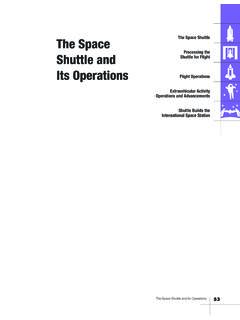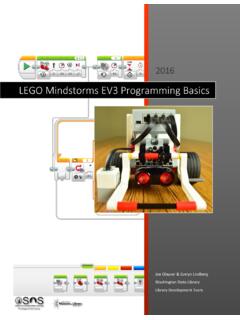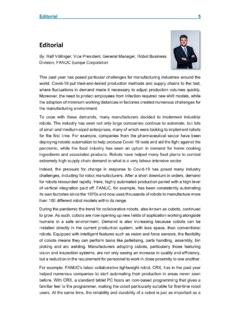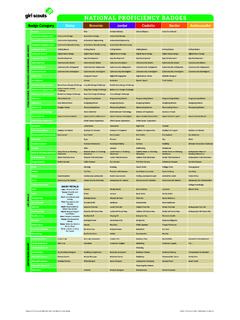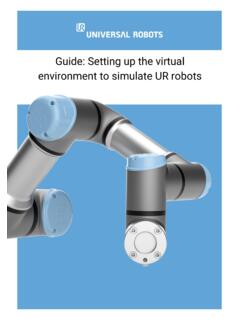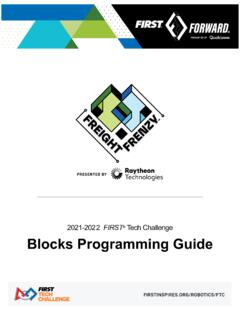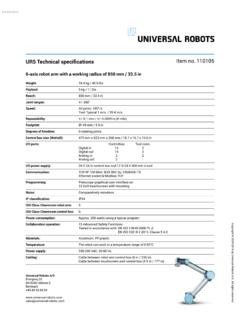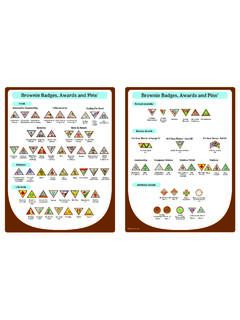Transcription of Robotics in the Classroom - NASA
1 Robotics in the Classroom Introduction to Robotics A collaborative unit for 5th and 6th grade students in science, math, and language arts Wright Patterson Air Force Base Educational Outreach Office This publication is Public Domain and is not protected by copyright. Permission is not required for duplication. Robotics in the Classroom Grades 4 6 Wright Patterson Air Force Base 1 Acknowledgements This publication was developed for Wright Patterson Air Force Base with the assistance of educators from the TIES Program (Teachers in Industry for Educational Support) and professionals from Wright Patterson Air Force Base under direction from the Educational Outreach Office.
2 Writers: Andrew Toye, and Beth Williams Spinning Hills Middle School TIES (Teachers in Industry for Educational Support), an educator externship program Project Manager/Editor: Wendy O Toole Aerospace Education Specialist Educational Outreach Office Wright Patterson Air Force Base Contributors: Erik Blasch, PhD, physics and Robotics Air Force Research Lab Wright Patterson Air Force Base Bruce Clough, Technical Area Leader (Air Vehicles/Flight Control) Air Force Research Lab Wright Patterson Air Force Base Jason Crum, MindStorm robots and Battlebots veteran Wright Patterson Air Force Base Paul Hicks, Senior Msgt USAF Robotics demolition expert Wright Patterson Air Force Base Jason Lawson, Lt USAF - robot competitions Air Force Research Lab Wright Patterson Air Force Base Jeff Seeloff, Chief Msgt USAF, Robotics demolition expert Wright Patterson Air Force Base Robotics in the Classroom is a multi-year project sponsored by Wright Patterson Air Force Base to bring real-world applications of science and math concepts to the traditional Classroom .
3 The Educational Outreach Office at WPAFB is committed to motivating students to explore the world of science and technology, and to increasing student awareness and excitement in all fields of math, science, aviation and aerospace Robotics in the Classroom Grades 4 6 Wright Patterson Air Force Base 2 Table of Contents Curriculum Unit Overview narrative 4 Summary Chart 6 Section One History and Uses of Robots 8 Section Two Components of Robots 38 Section Three Design of Robots 49 Transfer Activity Mindstorms robot Kit 58 Appendix One robot Resources 59 Apprendix Two: Gear Basics 61 Robotics in the Classroom Grades 4 6 Wright Patterson Air Force Base 3 Curriculum Overview Summary Today, more than any other time in history, robots play a significant role in everyday life.
4 For the average person it is impossible to go through a day without coming into contact, one way or another, with a robotic device. This unit introduces fifth and sixth grade students to the development of Robotics during the 20th and 21st centuries while illustrating the prevalence of robots in the world today. Students will use the scientific method to develop their own designs for a robot that could be useful in daily life. Although the subject of Robotics is extremely vast, we have selected just a small portion to cover in this unit. Teachers should plan three to four weeks to cover the lessons that follow, excluding the transfer activity.
5 Big Picture To get the most from this unit, we advise arranging for a guest speaker to come to your Classroom and give a brief introduction to the field of Robotics . In addition to sharing real-world knowledge and anecdotes, a speaker will be able to answer students questions and generate excitement about the subject they will be studying for the next few weeks. Prior to the beginning of the unit, teachers should make their own robot to show the students. Obtaining Classroom Guest Speakers Guest speakers and demonstrations may be available for your Classroom from Wright Patterson Air Force Base in Dayton, OH. Wright Patterson supports community and educational outreach by either direct visitation to classrooms or distance learning venues.
6 For more information, contact the Educational Outreach Office at Wright Patterson Air Force Base: (voice) (937) 904-8622 (email) Preparation for the Unit Science, math, and language arts teachers will cooperate to: 1. Secure guest speakers. Consider resources such as parents of students, military personnel, local businesses, and hobbyists. There are many clubs and organizations based on Robotics . 2. Find an engaging video that discusses the progression of Robotics thorough the 20th and 21st centuries, and introduces major concepts and terminology. One suggested video is Let s Talk Robotics (15 min., grades 3-8) from NASA s Liftoff to Learning series.
7 Robotics in the Classroom Grades 4 6 Wright Patterson Air Force Base 4 3. On-line resources for free videos include: NASA Robotics Educational Project The Lunar Rover Initiative from Carnegie Mellon University The Organic robot from Circuit Cellar Magazine an easy first robot to build with everyday items. NASA Jet Propulsion Lab on-line videos of robotic space exploration NASA JSC ROVer Ranch Interactive website and robot primer for children. 4. Build a sample robot available for the opening activity. (See the appendix for details on how to locate a good kit, or use the organic robot at ) 5.
8 Since the unit is a collaborative effort among language arts, math, and science teachers planning ahead is necessary. Teachers must understand how their lessons fit into the big picture. 6. Make photocopies of the handouts and activity pages found in this unit. Robotics in the Classroom Grades 4 6 Wright Patterson Air Force Base 5 Unit Overview The following overview includes a brief summary of each Authentic Learning Task (ALT), and provides a synopsis of the tasks required in each of the three sections. The table also cross-references the collaboration of concepts addressed in the teaching disciplines of science, math, and language arts.
9 Unit Overview Section I History and Uses Of Robots Section II Components of Robots Section III Design of Robots ALT 1 robot Uses (Science) Students will examine, through video and discussion, the multiple uses of robots--past, present, and future. ALT 1 Physics and Robotics (Science) Students will demonstrate an understanding of the relationship among mass, force, work, power, and energy, and how those terms have an impact on the selection of robotic components. ALT 1 robot designing using the Scientific Method (Science) Students will apply knowledge of the process of the scientific method as they design a new type of robot .
10 ALT 2 Instruction Sequencing (Math) Using logic and sequence, students will write instructions to complete given tasks. ALT 2 robot programming (Math) Students will be introduced to the different kinds of robot sensors. Students will use distance formulas and ratios, instead of a sensor, to be able to tell a robot how far to move. ALT 2 robot Design Sketch (Math) Students will make drawings of their robot using the concepts of proportion and scale. ALT 3 Examining Robotic History Through Writing (Language Arts) Students will infer the impact robots have had on society throughout history, and demonstrate their knowledge and opinions through writing.






